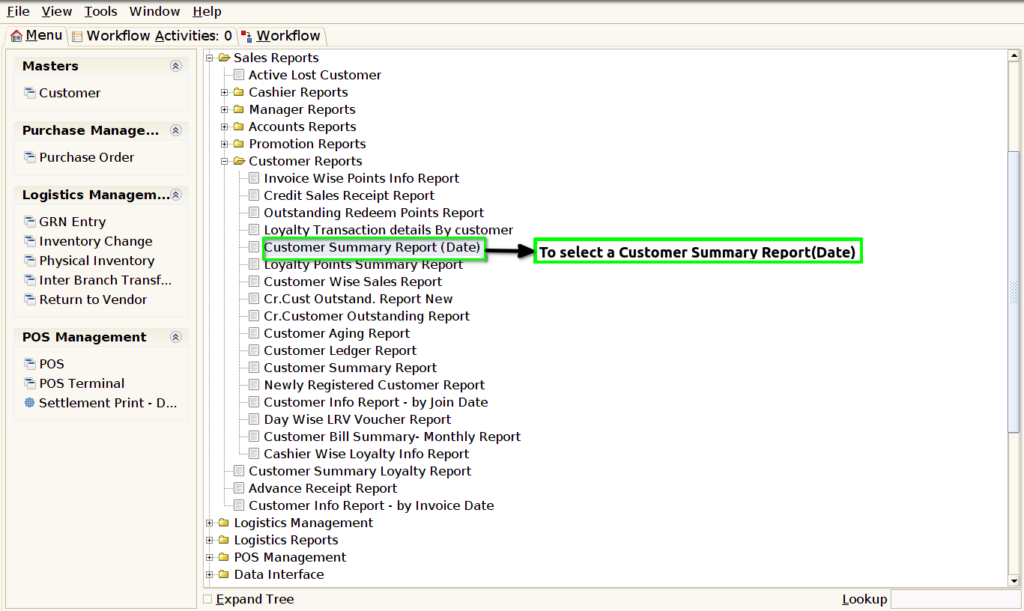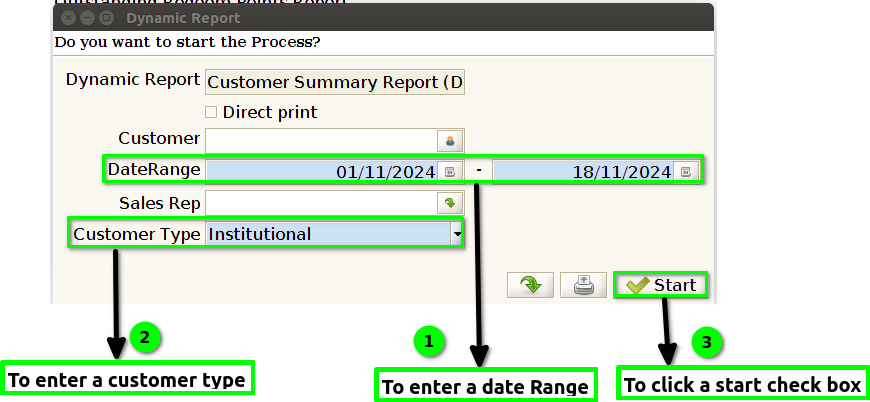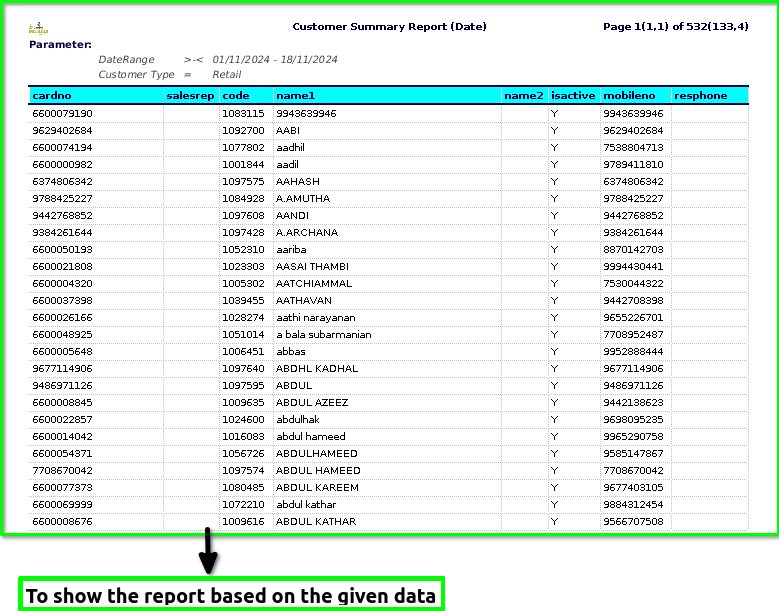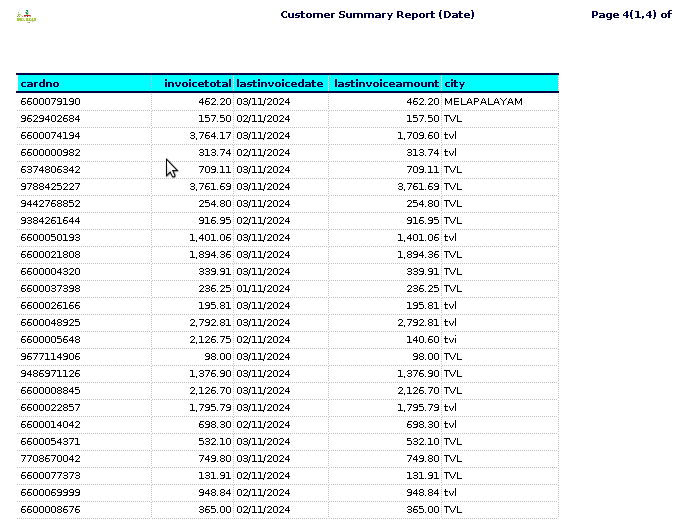TO CREATE A CUSTOMER SUMMARY REPORT (DATE)
A Customer Summary Report (Date) typically refers to a report that provides an overview or summary of customer-related information, filtered or segmented by a specific date or date range. This kind of report is often used by businesses to analyze customer activity or behavior within a given time period.
User Access
Who Can Access
- Pothys admin
- Back Office
- Purchase Manager
- Manager
What User Can Do
- View Reports
- Customer Summary Report(Date)
Pre-Requisite Activities
- Date Range
- Customer
- Customer Type
- Sales rep
Business Rules
- Date Range Selection-The report must allow the user to select a specific date or a date range (e.g., a single day, week, month, quarter, or custom range).
- The date range selected must align with the reporting period. If a date range exceeds a predefined boundary (e.g., future dates or too far in the past), the system should notify the user and prevent the selection.
- The report will pull customer data from the database where the transaction date or account activity falls within the specified range.
- Customer Data Aggregation- The report should aggregate data at the customer level, summarizing key customer metrics such as: – Total purchases, transactions, or revenue during the period – Number of orders or interactions – Product categories or services engaged by the customer – Payment methods used – Outstanding balance (if applicable).
User Interface
STEP 1: To select a Customer Summary Report(date).

STEP 2: To enter a Date range and to enter a Customer Type in this fields are mandatory.Then to enter customer and Sales rep field its an optional.Then finally to click the Start check box to run the process.

STEP 3: Once to complete the process to show the report based on the given data.




STEP 4: Card number – typically refers to a unique identification number assigned to a customer by a business or service provider. This number is often associated with a customer loyalty program, credit card, membership card, or any other form of account that the business uses to track customer transactions, preferences, or rewards.
Sales representative (sales rep) – is an individual who is responsible for selling products or services on behalf of a company or organization. The primary role of a sales rep is to engage with potential customers, understand their needs, and convince them to purchase the company’s offerings.
Code – is a unique identifier assigned to a product, typically used to differentiate it from other products in a catalog, inventory system, or retail environment. Product codes are crucial for tracking, managing, and selling products efficiently.
Name1 & Name2 – refers to the name of an individual or organization who purchases or intends to purchase goods or services from a business.
Mobile number – It refers to the phone number of a customer, typically used in business or customer service contexts to contact the customer via their mobile device.
IsActive – typically refers to a status indicator that shows whether a customer is currently active or inactive in a system or service.It generally means: – IsActive = True/Yes.
Isinstitutional – generally refers to anything related to institutions, which are organizations, systems, or structures that have a significant role in society, such as schools, governments, hospitals, banks, or corporations.
Pricelist – is a document or list that provides the prices of various products or services offered by a business or organization.
Credit limit – is the maximum amount of credit a lender or financial institution is willing to extend to a borrower, typically associated with credit cards, lines of credit, or loans.
Open balance – refers to an amount of money that is still outstanding or due, typically on an account or a financial statement.
Credit available – refers to the amount of credit you can still use on a credit account, such as a credit card, line of credit, or credit loan, without exceeding your credit limit.
Join date – typically refers to the specific date when someone officially becomes a member of an organization, group, platform, or service. It could refer to when an employee starts working at a company, when a user creates an account on a website or app, or when someone joins a club, team, or community.
Current year points – could refer to a variety of things depending on the context, but it generally implies a point system that is reset or calculated annually.
Points to be redeemed – refers to the amount of loyalty points, reward points, or credit that a customer has accumulated and is eligible to exchange for a benefit, reward, or service. These points are usually earned through a rewards program, such as those offered by retailers, airlines, credit cards, or other businesses.
Last redeemed points – refers to the most recent instance in which a person used or exchanged their accumulated loyalty, reward, or credit points for a benefit, product, or service. It tells you the last transaction or activity in which points were redeemed from a rewards program.
Last redeemed date – typically refers to the most recent date when a voucher, coupon, reward, or code was used or activated. This could apply to loyalty programs, promotional discounts, gift cards, or even certain types of digital content.
Invoice count – typically refers to the number of invoices that have been issued, processed, or generated in a particular period or for a specific customer or business activity. It helps in tracking the volume of transactions or billing events.
Invoice total – is the final amount that needs to be paid on an invoice. It is the sum of all charges listed on the invoice, including the cost of goods or services, applicable taxes, shipping or delivery fees, and any discounts or adjustments.
Last invoice date – refers to the most recent date on which an invoice was issued. It marks when the invoice was created or finalized, and is typically the starting point for payment terms, due dates, and tracking payment history.
Last Invoice Amount– Last Payment Amount – Outstanding Balance – Recent Transactions In some systems, the report will show the most recent transaction or invoice with the corresponding amount.
City -is a large, densely populated urban area that is typically characterized by a high level of infrastructure, including buildings, roads, transportation systems, and utilities. Cities serve as centers of commerce, culture, government, and often innovation.
Training Videos
FAQ
SOP